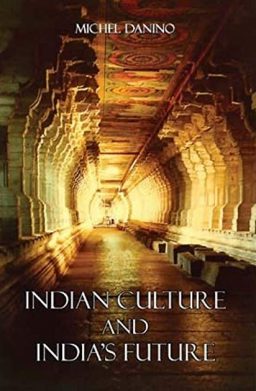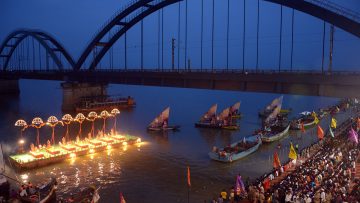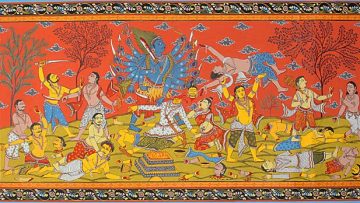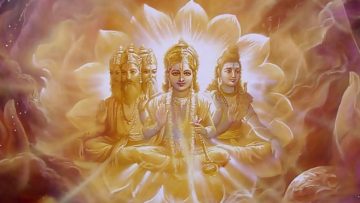‘Indian Culture and India’s Future’ is a contemplation on the questions like what is so valuable about Indian culture, is it relevant in the modern world, would it disappear under the pressure of globalization, and how should Indians, and more specifically Hindus, deal with the new concept of ‘dialogue of civilizations’. The book frankly is addressed to the ‘confused Indian’, says Danino.
He begins with the question, is Indian culture obsolete? It is the worldview that great people like Vivekananda and Shri Aurobindo moved and worked with, that Danino wants to understand and analyse. He is curious about the present ‘angry young Indian’ and his reaction to his times, and the condition of his country. He notes that many of them have a firm belief that culture is good for the elderly, renunciate, and tourist; it would never help us build tomorrow’s India. The sooner we get rid of these relics, the faster we can progress.
But, states Danino, they are ignorant about the idealized view of the west, and distorted notion of India’s heritage. The life in many western societies is not as rosy as it appears to be. Also, we are experiencing the ill effects of their so called development, in forms like overheating of the planet, credit crunch, terrorism, and depression. Every country has its fair share of perversions, but a correct question that needs to be raised is, are the diseases of the western society healing, or are they seething out of control?
It is with the obvious answer to this question in their mind, most Europeans and Americans followed Vivekananda; and endeavoured to trace the relevance of Indian knowledge and civilization. Danino comments that Indian civilization is like a huge old tree, weighed down by dead branches, creepers, and weed. What we need to do, is to clear them out; and not pull the tree down. The tree is still capable of fresh growth and sweet fruits of great spiritual, academic, as well as material growth.
“India was a pioneer in shipping, metallurgy, and textile production; she had a flourishing agriculture and external trade, her own systems of medicine are still alive today, and a long list of innovations in every technique from brick-to-jewel making to water management.” This golden era was distorted by the Muslim invasions, and further destroyed by the British. But, after being independent for decades, the blame game won’t work, says Danino.
The basic principle of Indian culture is dharma or dutifulness. “What do our modern rulers do? Step no.1: Perversely equate dharma with religion; step no. 2: declare that secularism demands the separation of religion from politics; step no.3 therefore, let us carefully keep dharma out of politics. Not only politics, but out of education and public life as well- out of our brains, out of our lives.”
Let us try and chop off the weed. If at all we want to imitate the West, let us copy their self-discipline, constant search for innovation, and not its greed and tragic lack of direction.
Danino proceeds with introducing some of the most relevant aspects of ‘a thousand-branched tree’ of Indian culture, which lay neglected, or worse intentionally hidden.
He brings to attention the scientific mind of ancient India, with examples like Jyotisha texts, Shulba Sutras, and Vaisheshika Sutras, which enlist scores of accurate scientific knowledge. Discussing the gifts of India to the world, he notes several problems like, loss of material, difficulties in chronology, and lack of documentation.
He notes Indian contributions of spirituality and philosophical thought, all-encompassing Dharma-s/ religions like Hinduism, Buddhism, Jainism, Sikhism, etc. (that spread through a peaceful and conceptual acculturation, rather than hostile and forceful conversions), languages like Sanskrit, literature like Gita, epics and Puranas, scripts like Brahmi, Kharoshthi, and others, arts and architecture, ideas of governance and society, apart from the obvious sciences like mathematics, physics and quantum physics, chemistry, geometry, geography, astronomy, medicine, technology, etc.
Danino notes that India has been a peaceful civilizing force: “India’s cultural expansion has had a peculiarity: it stamped out no pre-existing regional cultures. The spread of Buddhism and Hinduism did not spell the end of Confucianism in China or Taoism or Shintoism in Japan. The resulting impact was certainly deeper and longer-lasting than that of a brutal military conquest.”
“In any colonial domination, the conqueror is more often more profoundly influenced by the conquered than he could have anticipated”, Danino states with the example of France, Britain, America and Germany. The influence of India on the West still continues through saint preachers like Vivekananda, Ramana Maharshi, and Shri Aurobindo.
Danino notes India’s love and reverence for the nature. Be it Rigvedic verses about the heaven and the earth, poems about sun and dawn, Bhumi Sukta of the AV, wide range of flora and fauna seen across Buddhist, Jain and Classical Sanskrit literature, or Sangam literature. Folk and tribal heritage also echoes this fact. Temples have their sacred groves or forests, which are never cut or encroached upon. Many rituals, vows, etc. also involve trees, animals or geographic bodies.
However, post-independence scene is not pleasing. Western utilitarianism and Stalinist Industrialization are the major causes. Forest departments are the first destroyers of the environment. Policy makers are clueless and careless. The industrial revolution may strip our liveable environment away.
Danino states that Indian culture is today at the crossroads. The colonial advent was more troublesome for India as it was diametrically opposed to her own temperament and culture. Unlike the Muslims, British thought of their presence in India as “a ‘divinely ordained’ civilizing mission”.
Macaulay had thought, ‘no Hindoo, who has received an English education, ever remains sincerely attached to his religion’. His speculation failed; he thought the roots of Hinduism to be shallow, but they quietly held fast. However, his educational strategy did succeed in creating a large educated class, anglicized and partially Christianized/ atheicized, which looked up to its European model and ideal.
And even after independence, this class of elite governed social and political life and assumed that in order to achieve fulfilment, India merely had to follow European thought, science, medicine, industry and socio-political institutions.
But, the most disturbing is the field of education. Kids are hardly aware of their own country; but they are well aware of all these. Higher education is hardly different. The so-called specialists in scientific fields know nothing about the achievements of India in their fields.
Our educational policies also systematically discourage the teaching of Sanskrit. Also, the history of India as we know it today, is composed either by colonial historians or natives under their influence. The influence of clashes like Hindu-Muslim or Aryan-Dravidian, etc. create further rifts.
The root of the problem in short is the discouragement we receive for every attempt of an independent expression, starting at school; due to which we have lost our ability to think by ourselves. We are always spoon-fed and often force-fed.
Yet, the author does not deny the inevitability of English education. He opines that there probably was necessity of shaking India out of her lethargy and make her open up to the world and face its challenges. We have to accept that we need one poison to kill another poison; but to continue its consumption even after the cure is over is beyond reason.
What the divisiveness of British Biblical thought did to India has been disastrous. Her inhabitants had never known themselves as Aryans and Dravidians; nor had they ever labelled their worldview as ‘religion’ (“a word with no exact equivalent in Indian languages”). Most importantly, not only was this segregation artificial; it was also insufficient. What had always been semi-fluidic was made iron-strong. Sadly, this labelling has become a part of Indian subconscious.
What we basically need is the method of harmonizing the material and spiritual developments, as India had provided in past as well. And we don’t need it for ourselves alone; we need it for the survival of the humanity. “Because the West ultimately believes in death, it ends up destroying the planet; because India ultimately sought the secret of life, it could restore the divinity of the creation, humans included”, comments the author.
Words like God, Religion, Secularism and Tolerance are words that we often hear. But fail to realise that these English words correspond to no clear Indian concepts. The Abrahamic God Jehovah in the commandments clarifies that he is jealous and therefore, we must not make or have any new gods apart from him. He also proclaims use of arms to defend his faith. In words of Shri Aurobindo, they invented a God-fearing man and us a God-knower and God-lover.
Religion and Dharma are also not identical. Indian or Pagan beliefs never divided faithful and infidels, never saw conversions, too. Rather, they preached ‘a’ way and not ‘the’ way. We have always believed that there can never be only one revelation, only one truth, only one last prophet, etc. For us revelations are continuous. This is why we can accept a new deity like Santoshi Mata so easily into the pantheon. We embraced her with a fascination of a discovery.
Secularism originally refers to the historical segregation of Church from the State or political power and education. India never had a State Religion. Thus the idea seems futile in India. The significance of Secularism is either in case of a sectarian spirit or where the State and Church are combined. India did not fit into either. “The Hindu certainly needs no lesson in tolerance.”
The two proselytizing Abrahamic religions are epitomized as tolerant and Hinduism is depicted as retrograde, medieval, superstitious and increasingly intolerant. Even the words like Hindu Fundamentalist, Hindu Fanatic are literally oxymoron, feels Danino.
We should come together to eradicate such non-sense ideas and get to find our role in betterment of our country. We also must pursue and renew our perennial search for the truth.
To act or not to act is and has been India’s dilemma. Danino notes that India has imbibed the extreme tolerance and Ahimsa in her deeper subconscious; so much so that she also refuses war against evils of corruption, dirty politics and naxalism, etc. He points out that sadly, today’s education teaches pupils that Gandhi is the father of the nation; but fails to imbibe the Gita principle of fighting against Adharma. Had Gita not been kept out of sight and hearing of today’s youth; India would have had a much better shape.
India is a civilization, more than a nation. But, the shocks of time have left this civilization wounded. And sadly, “modern India appears to have developed the strange doctrine that only by sweeping the past under the carpet can we bring about a harmony- until the accumulated debris bursts in our shocked faces.” There clearly are two types of distortions she has faced; Factual and Model. Factual Distortions include ideas like Aryan Invasion Theory that is rather a pillar-cum-counterpart to Nazi ideology of 19th century. This did serve the purpose of Divide-and-rule; but modern excavations, studies and research has proved that there was no such invasion or migration in 3rd or 2nd millennia BCE. Also, modern genetic studies have proved a continuous existence of Indian population in this terrain for at least 40, 000 years.
Another such idea was of Dravidian, Dalit, and Tribal Separateness. Just like Aryan-Dravidian clash; we rarely find significant proofs to this claim. Hinduism as we see today is a result of centuries of give and take between the classes, masses and tribal cultures.
The ill- known records of Muslim rule in India and the horrendous and hideous activities they performed are kept under the carpet; for the fear of offending today’s Muslims and being labelled a Hindu Communalist. But the nation surely has the right to know her history. “No self-respecting nation wants its victims to be denied remembrance.” Just like Muslim history, even the colonial history is supressed under the carpet; and shockingly, so is the freedom struggle.
Talking about the Model Distortions, division of Indian History in Vedic-Buddhist-Muslim-British periods is logically and practically wrong. And if the earlier three names are based on religions, why not a Christian period. Her contributions and achievements are smartly hidden or disrespected, so is the continuity of cultural identity and the pros of its associate bodies like the caste system, feels Danino.
Christianity and Islam have used the fear of Hindu majority of being called unsecular and anti-minority, to proselytize in subtle and clear ways. Sadly, such a disruption inflicted on India’s social fabric in the name of religious freedom, is the least concern of our leaders. Most of Indian tribes have already faced deep cuts. They are fast on their way to alienation, rootlessness and division, the bitter fruits of conversion.
Islam adds a military dimension to the missionary one. Alarm is palpably grown across Europe and they hope that multiculturalism will somehow take care of the problem. Thus we have a triple task on hand. Firstly, we must reject collective amnesia and study the history of religions- of both the conquerors and the conquered.
Secondly, non-aggressive cultures must avoid the snare of unity of religions: an impossible proposition as long as any of them claims exclusive property of the truth and a divinely ordained mission to overrun the earth.
Lastly, the surviving ancient cultures of the world must strengthen their naturally fraternal bonds and join forces, realizing that in union there is strength. Strength not to conquer or convert, but simply to survive and enrich one another.
We are told that the world has shrunk to become a global village. This may also result in our so-called dialogue dyeing too soon in a well-regulated monoculture and one-track life; in which, cultures will be no more than an academic curiosity of the past. But it is unlikely as our very nature rebels against uniformity and drives to multiplicity. But, how do we ensure that these pluralistic and multicultural lines still produce a harmony and not a cacophonous bloodbath?
He wishes to propose an alternative approach, which is to look at humanity as nothing more than an experiment. Indian expansionism was never a military phenomenon, but an invasion of peace. This literally sums up the difference in civilizational behaviour.
Today’s call for dialogue is mostly in the context of a perceived threat: with Islam- a clearly physical threat and to a lesser extent with China, a rising economic rival. India is beginning to receive attention only insofar as she might become another economic superpower.
There are two necessary things before a process of such a dialogue. Firstly, a true respect of difference, an absence of any sense of superiority, racial or cultural, an openness that enables one to appreciate ad attune to an alien culture.
The second condition is an end to all forms of political, economic, religious or cultural aggression, not just in form; but also in intent. India has been a victim not only of terrorism, but also of the biased treatment by the USA, UK, and other western countries.
Frankly, she has herself to blame for putting up with such constant bloodletting as much as the flawed policies of these countries. Sadly, the portrayal of Indian culture by western and Indian academia and media is corrupt.
The American Model of Melting Pot or Assimilation Model of France and Britain, is probably not suited against the Salad Bowl or Mosaic Model needed for distinct identities of various communities. Diversity and pluralism cannot reach a harmony without finding some underlying unity. Indian model of a ‘thousand-branched tree’ is far more suited for such a dialogue.
The world is not going to adopt the model overnight. It must first reach the end of its line of experiment. In India, we do see Muslim and Christian moderates, living in perfect harmony and sync with the Hindu majority. What India can offer in this situation is a hunt for a common base and awakening of the national consciousness. Hinduism in view of Vivekananda and Aurobindo was after all, exploration and growth of our human potential.
To purchase a copy for yourself, click here.
Disclaimer: The opinions expressed in this article belong to the author. Indic Today is neither responsible nor liable for the accuracy, completeness, suitability, or validity of any information in the article.











